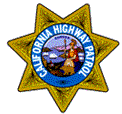

CALIFORNIA HIGHWAY PATROL
MOBILE RADIO EQUIPMENT, 21st CENTURY
2001-2012+
This page is a summary of the typical radio equipment found in most CHP patrol cars as of the late-2000's. It is best understood after reading the main CHP Patrol Car Radio History pages here. This page basically covers the CHP equipment found in cars from 2000-2011, before the new CPVE computer-controlled equipment began to be installed in late 2011. None of this equipment was being installed in new cars as of late 2013, although much of it is still in use in 2019. See paragraph below.
As of January, 2011 the CHP was still using the same equipment as detailed here, although the fleet will eventually fully transition statewide to a new mobile radio system, the Consolidated Patrol Vehicle Environment (CPVE.) The CPVE equipment was originally designed by Visteon Tac-Net, and it used a touch-screen computer to control all radio and emergency lighting functions, interfaced to up to five mobile radios mounted in the trunk. The new system was supposed to be funded in stages, with contract awards being made on a piece-meal basis over the next several years. Because of the current economic crisis, this may be slower in coming, however the new contract was given to Rockwell Collins for the CPVE equipment and as of 2011 a number of the new CPVE cars are in service. See the CHP 2012+ radio page here. But please note that the CHP is now dropping use of the CPVE equipment and returning to the older scheme of a mobile radio and a separate laptop computer. The new mobile radios will be a multi-band Kenwood design. The touch-screens and trunk full of equipment will be gone.
The modernized radio system will continue to use the existing low band analog infrastructure, however a number of new frequencies are being added in that spectrum, namely some 39 and 45 MHz channels. There will be more than one mobile radio "drawer" installed to allow multiple band operation. The portable radios and the associated "extender" mobile repeater were changed to a 700 MHz P25 digital system. The first contract was awarded to E.F. Johnson for the portable radios. These as of 2019 have been replaced with Motorola APX series radios. I do not have information yet on how they plan to equip the motorcycles, since the Visteon equipment is intended for the cars and a motorcycle prototype was being studied in 2004. I will update these pages with new information when I get it.
NOTICE: Almost all of the equipment described here is still in use, somewhere, even though the CHP was transitioning to the new Rockwell Collins CPVE equipment and Whelen LED lighting as of summer 2011. I get at least three inquiries per month, mostly from people in other states and foreign countries, asking where they can buy this equipment. The short answer is, you can't! I do not have any of this for sale and I do not have manuals available.
GE RANGR MAIN MOBILE RADIO:
In late 1988, the CHP began to replace their existing Motorola MICOR mobile radio equipment (placed in service beginning in late 1977) with GE RANGR radios, featuring the S810 control head. This replacement program presumably took several years to complete. Unlike the Motorola CHP product of the 1970's, the GE RANGR incorporates siren and lighting control within the control head itself, at least in the automobile version, which interfaces with a special Federal Signal siren and lighting controller box in the vehicle trunk. The S815 motorcycle version uses a scaled down control head, without that feature. The S800 series control head design was originally developed by GE solely for the CHP, although GE found that they soon became popular with many law enforcement agencies and today are widely used throughout the USA, but in different version numbers than the "made for CHP" control heads.
As always, all equipment is low band, and operates in the 42 MHz range, except for a number of "new" channels in the 39 and 45 MHz assignments. Each region typically uses two channels; a primary and a secondary channel. The primary channel is the local channel, used for routine dispatches and so forth. The secondary channel is the "Blue" channel, and is the same frequency statewide. It is used for tactical coordination, and by the spotting airplane in some areas. The Blue channel was originally conceived to allow units to have a means of contacting a base station or other cars regardless of what area they traveled into, but since the GE equipment is capable of storing all frequencies used by the CHP, statewide, in memory, the importance of the Blue channel has been diminished. It appears that the "single tone" tone burst on transmit feature, last seen on the MICOR radios, was finally eliminated with the GE contract, since it was rarely used.
The GE model numbers on the radio drawer are:
AXA9HHTR-139B 19C852050P 8 Rev D
The contract number was 1-88-58-30, Dated April 20, 1988
The purchase order was # 40041, Dated July 29, 1988
There may have been some delivered with different revisions than Rev. D. This was the initial model of the RANGR radio, sometimes referred to as the "RANGR 050."
The CHP manual states the following about the radio:
---------------------------------------------------------------------------
The low band 110 Watt mobile radio 19A705488P1 is the same as the 110 Watt RANGR low band radio 19C852050P8, except for the following modifications. On the system control board, the circuit board pattern was cut between HC603-Pin 5 and IC 603 Pin 1, and a jumper wire was added from IC 608 Pin 3 to HC 603 Pin 5. Also, Diode D604 was removed, and fuse 19A142950P44 with fuseholder 19A142950P43 were added. The speaker and speaker mounting bracket were deleted.
"Cutting the circuit board pattern and adding the jumper applies the limited Channel Guard tone to J801 Pin 26, where it is routed to the control unit for decoding. Removing Diode D604 allows the operator to hear the GE-Star identification sidetone before transmitting.
---------------------------------------------------------------------------------------------
This doesn't seem to make much sense as CHP did not use GE-Star identification tones, but the above is a direct quote from the manual.
As in the previous MICOR equipment, there is an "S" and a "C" button on the microphone. One button places the mobile transmitter on the car-to-station frequency, while the other button places the transmitter on the car-to-car frequency. This system is a carryover from the days when the mobile radios did not have dual receivers capable of monitoring both the station and the car channels. The purpose of including the S and C buttons on the microphone today appear to be 1) to prevent the dispatcher from hearing car to car traffic not intended for her and 2) to assure that mobiles with the "monitor" feature (listen to car and station channels simultaneously) disabled will still hear car-to-car traffic directed to them. The small pushbutton on the right side activates the PA function immediately such that there is no need to reach the control head to select "PA." The original shipment of GE RANGR mobile microphones did not have that pushbutton - - it was added later, in approximately 1992, presumably the same time the keypad overlays were changed and upgraded firmware installed in the control heads.
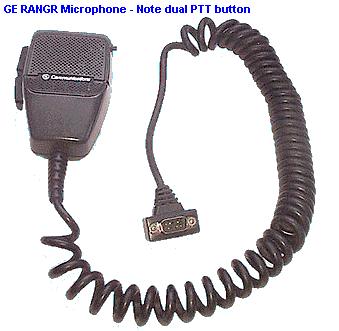
The GE RANGR is a 110 Watt mobile radio, in which the channel programming and some other features such as the CTCSS tone selection can also be carried in the "intelligent" S810 control head rather than just in the radio drawer itself, if desired. The frequency and tone information is stored in a Xicor X2212 EEPROM chip (electrically erasable programmable read only memory) in the radio chassis itself, which was originally programmed by a GE "TQ-" series suitcase programmer. In the lower cost S550 and other "ordinary" GE control heads, the control head contains just channel display circuitry and the channel/volume/squelch controls. In the S810 series control heads, there is additional circuitry which mimics the action of the programmer such that the control head "programs" the radio by downloading to the EEPROM in the radio. However, there is still the necessity of a programmer to originally program the S810 control head with all the appropriate information.
The advantage of all S800 series heads is that far more information can be programmed into the radio system than could be done with the "stock" Rangr system, and one control head can also contain all the alpha-numeric display information and channel assignments necessary to allow that radio to be used anywhere within the State of California.
This equipment, while still in use, dates from 1987 and has been discontinued by its manufacturer, which became Ericsson/GE, Tyco-M/A Com and now Harris. Product support for the Rangr is becoming a serious consideration. The actual manufacturer of the RANGR equipment was JRC, a Japanese firm, which built the equipment under contract for GE. The days of the GE Rangr equipment are now numbered, although since few mainstream manufacturers are interested in producing a conventional low band radio, there are few replacement options available. As mentioned above, CHP will be gradually replacing the Rangr fleet with new Kenwood low band radios as well as VHF high band and 700-800 MHz equipment, controlled by the CPVE touch-screen computer control system.
The generic RANGR S825 mobile control head was made available in a number of versions depending upon frequency band and system of use. But the earlier S810 head, its firmware and software were special for CHP, as was that for the S815. Within the S810 category there were several versions. Shown below is a typical head in current service with the CHP (August, 2001), and below it an overlay with a slightly different layout, as was used in the oldest installations before standardization on the Federal Signal Vision/Signalmaster lighting system. The S810 and S815 CHP version control heads were originally intended to be programmed by the TQ2310 "suitcase programmer" which in turn contains special instruction set "eprom" chips unique to CHP programming, however later a computer programming interface box (TQ3330) and DOS software was developed to supersede the suitcase programmer.
The present CHP firmware in the S810 control head allows the LCD to display information about the Signalmaster amber arrow lamp in addition to the pushbutton illumination. For example, when the Signalmaster is in use, the control head display will alternate between the current radio status and a --------> or <----------- symbol to show the pattern of the Signalmaster when it is turned on.
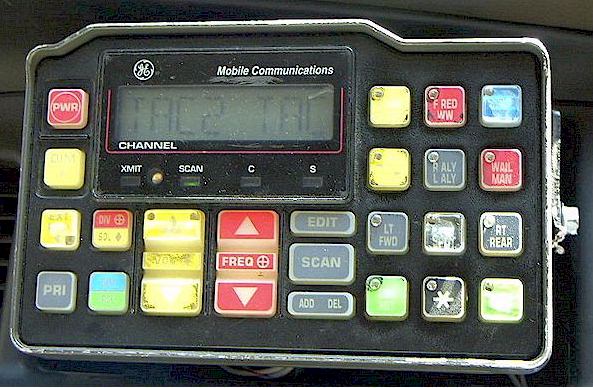
Thanks to Jim Opocensky for the above control head photos
Summary:
Cars: S810 Control Head + GE RVR16 Repeater or Pyramid replacement (See below)
Motorcycles: S815 Control Head + GE M-PA Repeater (See below)
GE 1988 VINTAGE MOBILE EXTENDERS:
As in previous years, a mobile extender package was included in 1987 when the RANGR equipment began to be phased in. The extender was a GE Mastr Executive II unit of identical appearance and RF circuitry to the previous generation of Mastr Executive II mobile extenders (see main CHP Radio web page,) but in this case the logic board was an improved and modernized version and the model number changed to RVR-16HS. In the motorcycles, which have had extender-repeaters in them since approximately 1996, a GE M-PA hand-held radio was reconfigured as a mobile simplex repeater, and mounted in a small sheet metal box directly on top of the motorcycle RANGR radio, with its antenna hidden down beneath the windshield in front of the fuel tank. Either extender unit operates on 154.905 MHz, and normally listens for transmissions on that frequency from a nearby portable which is then re-transmitted through the GE Rangr mobile out on the car-to-station channel on 42 MHz. When the GE Rangr is receiving traffic on 42 MHz, that traffic is re-broadcast through the extender unit (if it is enabled) on 154.905. During the time the extender is transmitting, it is also interrupting its carrier at a preset rate to listen for traffic from the portable unit. This is to give the portable priority, and can be heard as a slight "chopping" of the signal from the car on 154.905 MHz. Further details on extender operation can be found on my main CHP Radio page hyper linked at the beginning of this page.
PYRAMID MOBILE EXTENDERS:
The GE Executive II mobile repeaters are no longer supported by the manufacturer, and were supplemented with a mobile repeater of essentially the same function, but in a much smaller package, made by Pyramid Communications of Huntington Beach, California. The Pyramid unit is built into a small case about the size of an external computer modem, and is microprocessor controlled. This model is a special design made for CHP in that the connector matches that of the former GE Executive II RVR unit such that they are interchangeable. Pyramid manufactures the current line of mobile repeaters for GE (M/A Com) as the OEM . The Pyramid repeaters were initially tested in 2001 and adopted later in that year, but were not used in motorcycles. It was my understanding that the Pyramid units would completely replace the GE units, however in 2010 the GE units are still seen far more frequently than the Pyramid equivalents, and by 2013 all VHF extenders had been replaced with 700 MHz P25 extender equipment (still by Pyarmid in the "conventional" cars still using the GE RANGR equipment.
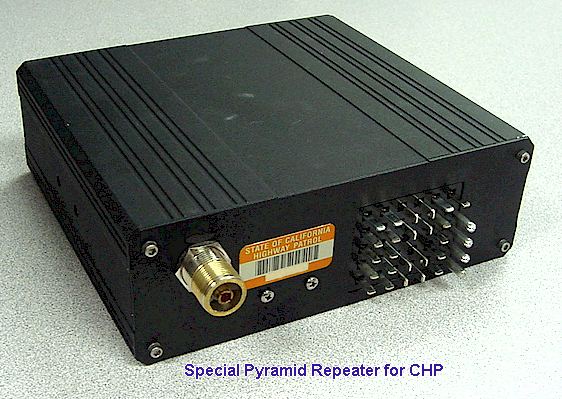
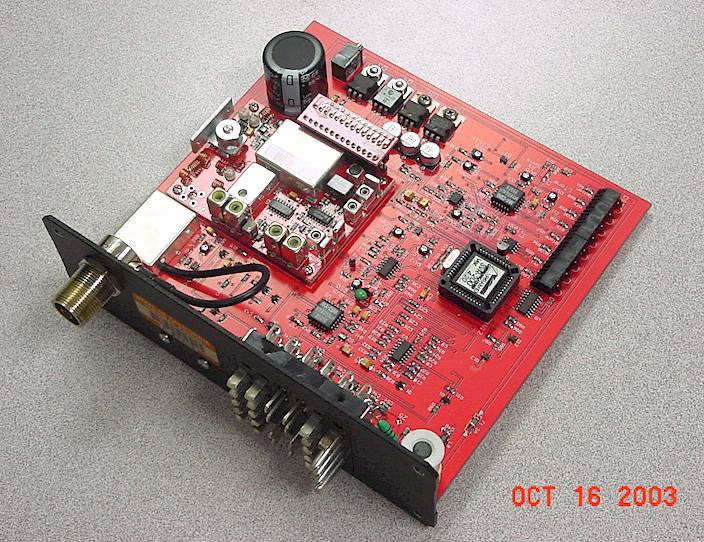
Photos courtesy of Pyramid Technical Support
PORTABLE RADIOS:
The radio through 2012 was the Motorola HT-1000, which replaced the multi-channel GE MPS synthesized hand-helds in use from approximately 1988-1997. The GE MPS radios were surplused through the State of California Dept. of General Services and many were then used briefly by local agencies and volunteer fire departments. The standard channel scheme of the old MPS was as follows, and was equivalent to what was in the HT-1000:
CH 1: 154.905 Simplex, PL for Car to Station (S)
CH 2: 154.905 Simplex, PL for Car to Car (C)
CH 3: 154.905 Simplex, No PL, Portable to Portable
CH 4: 154.920 Simplex, CLEMARS mutual aid
CH 5: 156.075 Simplex, CALCORD Mutual Aid
CH 6: 155.475 Simplex, NALEMARS National Mutual Aid
CH 7: 154.905 Simplex no PL (Portable to portable)
CH 8 through 12: As channel 7 above, although after 9/11/01 most areas are programming these channels for coordination with local law enforcement agencies which still use analog VHF high band systems.
Officers acting in the capacity of the old California State Police in Sacramento may instead have Motorola MT1000 UHF portables left over from the disbanding of the State Police when CHP took over their role.
Please note that these radios were replaced with 700 MHz E.F. Johnson portables by 2013, after broadcast TV vacated their channels beginning in 2009, and as the new CPVE mobile radio systems were installed (see my later CHP Radio pages.) Interestingly, this means that CLEMARS, CALCORD and NALEMARS usage will no longer be possible from the hand-held radio, only from the vehicle, until 700 MHz standards and systems are adopted for these common uses on 700-800 and digital modes.
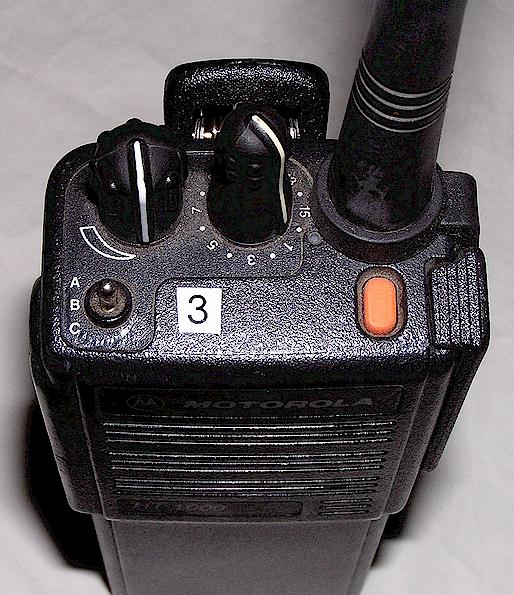
MOTORCYCLE EQUIPMENT:
The CHP motorcycles also use the RANGR radio, but with a motorcycle version S815 control head as shown on the BMW motorcycle below. Originally, the Kawasaki 1000 motorcycles were fitted with a white fiberglass radio weather housing supplied by GE and marked "California Highway Patrol" on both sides. When the "Extender" repeaters were added to motorcycles, an extra spacer section was added to the white "GE" radio box lid to allow for the extra height of the extender equipment. Then, when the Kawasakis were replaced by BMW motorcycles, BMW supplied a streamlined radio weather housing with the cycle, big enough for everything, and the GE boxes were surplused out. These BMW motorcycles will be phased out after 2011 with Kawasaki Councourse police motorcycles as they are run out. See my CHP Motorcycle pages for more data.
MOTORCYCLE EXTENDERS:
As in the patrol cars, since 1996 there has been a mobile extender (repeater) which operates on 154.905 MHz and relays the transmissions occurring on the 42 MHz CHP system to a VHF high-band hand-held radio carried by the officer. See discussion above. The hand-held radios were initially GE "MPS" synthesized radios, but by the end of the 1990's they had been replaced by the Motorola HT-1000 portables as discussed above. The motorcycle extenders did not begin to be installed statewide until 1996, as there was some disagreement among state planners as to whether a motorcycle was a "suitable platform" for a mobile repeater.
The original 1996 motorcycle extender, still in use, consisted of a GE M-PA portable hand-held radio, reconfigured as a "simplex repeater" and mounted on a sheet metal tray which sandwiches in on top of the motorcycle Rangr radio and for which an extension section was added to the GE motorcycle housing. It is possible that some of these might be being replaced by the Pyramid Communications extender units, although as of 2011 the extender equipment is being migrated to 700 MHz and the portables changed to a 700 MHz model from E.F. Johnson.
The motorcycle extender antenna location has varied, but was usually it is located near the windshield of the motorcycle, between it and the handlebars. The current BMW cycles have the rubberized extender antenna located on the left side of the handlebars between the windshield and the left warning lamp housing. See photos on the motorcycle radio page. The maximum range expected of the extender is no greater than 1000 yards, hence there was originally an attenuator built into the system to reduce transmitter power and receiver sensitivity. The GE M-PA motorcycle extender differs slightly from the car extender in another aspect, in that it is configured to "defer" to a car extender should one arrive on the scene.
CLICK HERE TO GO TO THE SPECIFIC CHP MOTORCYCLE RADIO PAGE
LAPTOP COMPUTERS:
Beginning in the mid-1990's, the CHP began to add laptop computers to the mobile installations. This resulted in the re-location of the main radio antenna to the roof instead of the rear cowl area, because of radio frequency interference concerns. A typical computer installation is shown below. Most of these computers were supplied by Grid, NEC and Gateway. Many vehicles also had a Cingular 900 MHz GMSK Packet Mobile Data radio package installed - - up until about 2001 these used a small Motorola or Ericsson (C 791/M) RF package similar to a cellular transceiver, mounted under the wooden platform in the center (Caprice) or in the side area of the trunk, with the antenna glass-mounted on the right rear windshield area. There were a few rural patrol areas in which the cars were not equipped with computers.
The computers were not a true mobile data terminal, but rather a conventional PC connected to a Cingular Wireless data modem + subscriber transceiver supplied by outside contractors, using the same system that the first generation Blackberry and Palm PDA's used. The systems used by the computers were not completely standardized throughout the state, nor were they interfaced with law enforcement data systems directly. Hence most requests for driver and registration information are still being handled manually through dispatch. Coverage was not particularly reliable in most non-urban areas of the state.
As of approximately 2004, CHP seems to have standardized on Sierra Wireless MP 775 GPS Wireless Modems, trunk mounted now above the light bar controller, for the data communications, connected to either an on-glass old style cellular antenna or the new "hockey puck" GPS-cellular black antennas. The MP 775 is built like the traditional brick outhouse in a cast aluminum housing. The item shown on the left front of the unit below is the SIM card slot (this is a GSM module.) The MP 775 has serial and USB ports, but no Ethernet port. This data modem uses the AT&T (formerly Cingular) GSM system. See the 2009 photo below:
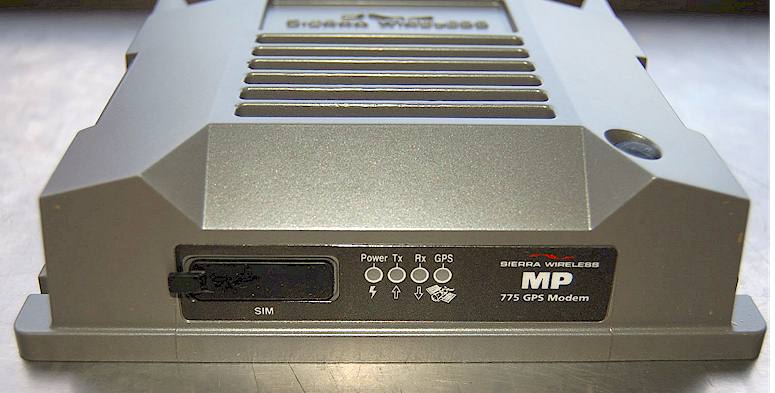
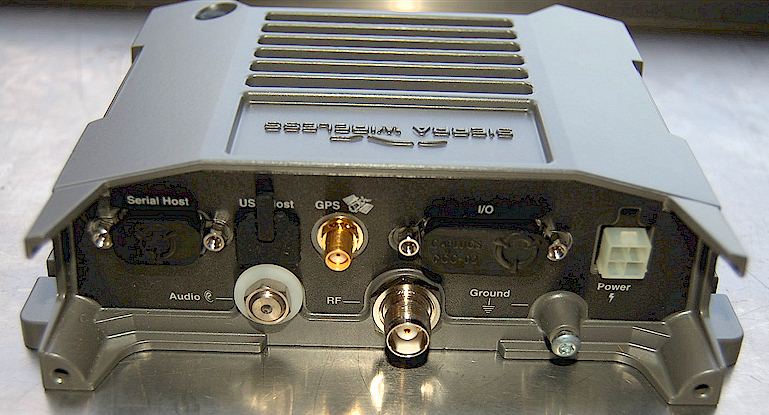
Installations newer than 2010 are being fitted with Sierra Wireless PinPoint X V4321-V "MDC Modems, similar to the above except that they have Ethernet and USB ports.
The photo below is of a 2001 Ford Crown Victoria in service in the East L.A. Div. in late 2001. As can be seen, little changed between then and 2009.
: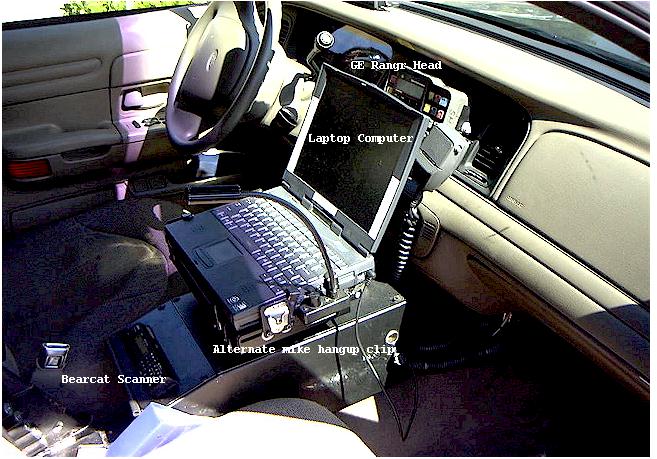
The photo below shows the interior of a 2009 model Dodge recently put into service by CHP, with the Bearcat BC780XLT scanner and traditional GE S810 control head:
Photo copyright and courtesy of Ten96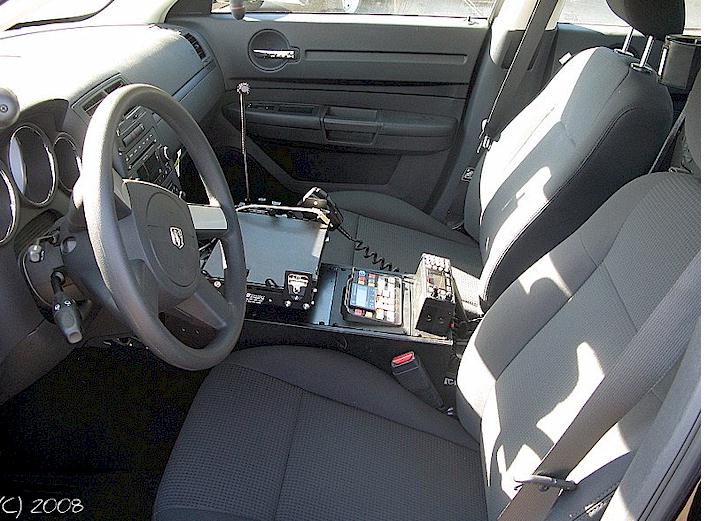
SCANNERS:
In 2000 the CHP was using late 1990's vintage Bearcat 760 mobile scanners, as well as some BC 780XLT models, usually mounted on the end of the metal console underneath the laptop computer mount. It was reported that the scanners usually have broken or missing knobs ! (This was a perennial problem with the older Regency M-100 and MX-3000 scanners of the 1980's.) The Bearcat scanners replaced the discontinued Uniden MR-8100 scanner (placed in service in the very early 1990's) which did not have that problem and appears to have been a better and more rugged scanner. There are still a few Uniden MR-8100's in service in CHP vehicles, although the majority have been surplused over the last five years. In approximately 2009 the Bearcat scanners began to be replaced with Grecom PSR-600 Digital Trunking scanners (see Grecom's website for further details, about $ 450 by mail order,) apparently first in areas where other local agencies had switched their radio systems to digital P25 formats. In addition to the Bearcat 760 and 780, there appear to have been some other models in use as well. The 2010 CHP Enforcement Vehicle installation manual shows only the Grecom scanner. Presumably the new CPVE installations will use the Grecom units as well, which have a USB interface.
It should be noted that while the Grecom scanner allows monitoring systems using digital P25 format, such as LAPD, it will not allow monitoring proprietary systems such as Motorola Astro Smart-Zone digital trunking, which is usually encrypted, such as the large system in use in Orange County.
BEARCAT 760 (Early):

GRECOM:
New, starting in 2010+
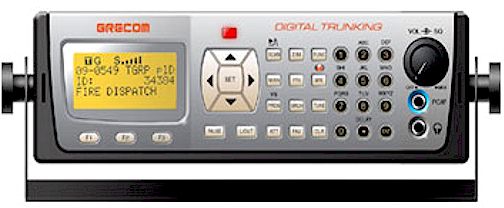
Note: At the end of 2012, Grecom announced that the company had lost its manufacturing plant in China and that there was some doubt as to when production would resume, if at all, as the company was in a state of interruption. It is unknown how this affected CHP maintenance and purchase of these scanners. The Grecom scanner is able to communicate with the new Rockwell Collins CPVE system (see separate page on the new equipment) via a serial bus. As of 2018, it appears that Grecom is gone.
ANTENNA PROTECTION RELAY BOX:
There is an antenna relay box as shown in the trunk compartment photos, for antenna sharing, used until about 2010 when the Grecom scanners began to be phased in. This box allowed the scanner to connect to the mobile radio low band antenna at the same time as the Rangr mobile radio. Inside the box, among other things, is a relay which is connected to the push-to-talk line of the 2-way radio and repeater equipment, such that whenever the transmitter of the mobile radio goes on the air, the scanner antenna line is disconnected from that line (and presumably grounded.) This keeps the scanner from being damaged when the car transmitter goes on the air. The same push-to-talk line which disconnects the scanner from the antenna also originally muted the scanner, but it is my understanding that the scanner is no longer being muted and that mute line output is just left loose at the back of the S810 control head. Apparently some installations are using the 154 MHz extender antenna to feed the scanner, and the relay box in those cases is connected in that line rather than the low band mobile radio antenna line. However, as they left Motor Transport at CHP, the relay boxes were all in the low band rooftop antenna line. The initial series of relay boxes were custom made by the CHP and State of California DGS shops, while the later boxes were made by Antenna Specialists Co. as a special order item. The boxes were in production by Antenna Specialists in 1981 and were also used on the predecessor Micor radio equipment removed from service starting in 1987.
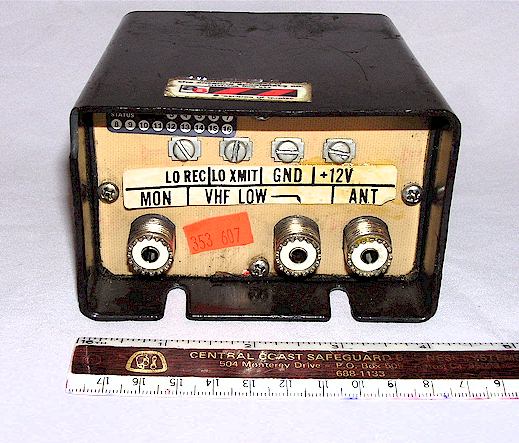
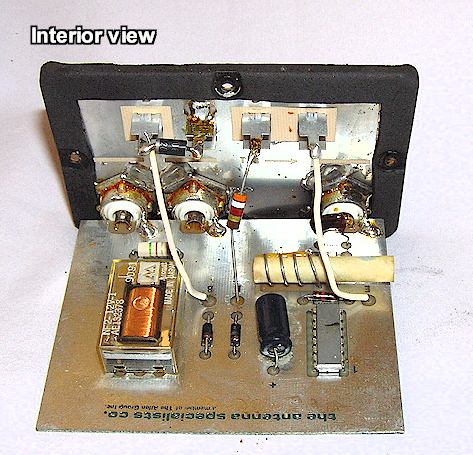
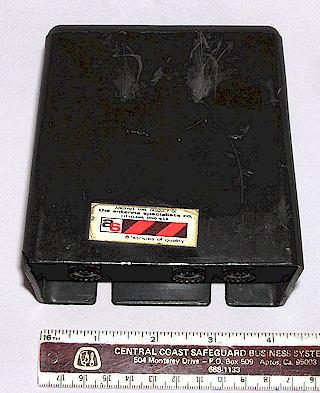
Box as wired and in use in 1998:
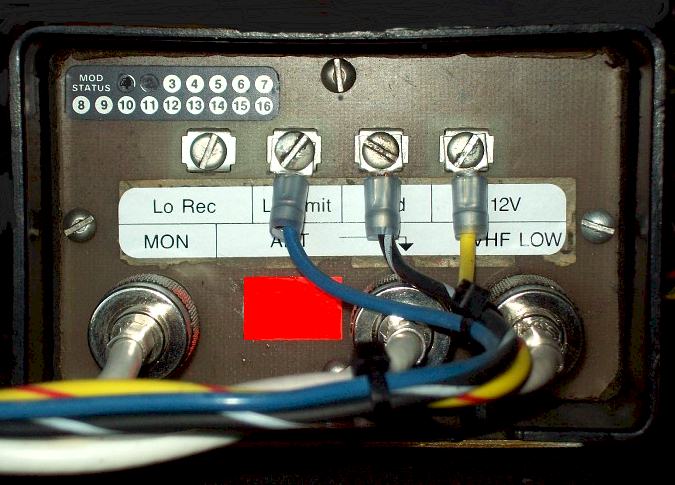
Note that the relay boxes have gone away. The new Grecom scanners used their own UHF quarter-wave antenna and do not share the two-way radio antenna . They were thus evidently limited to reception via a six inch whip. It is possible there may be some non-standardization in other areas where VHF scanning is needed, such as Monterey County, where an 18 inch quarter wave scanner antenna may be fitted.
SIREN AND LIGHT CONTROLLERS:
The GE Rangr control head includes an integrated control system for siren and lights, and that system was usually mated to a Federal Signal Vision™ "intelligent" light bar system which uses stepper motors to rotate the lamp reflectors. Not all patrol cars have light bars on the roof, some just have the red spotlight alone or a red light mounted inside at the upper edge of the windshield, with a number of rectangular blue/red/yellow lights mounted on the rear package shelf and a Signalmaster "arrow stick" amber light display. These vehicles are referred to as "slicktops" and the lighting systems used in them "Signalmasters."
Up to 2010 there were also a number of patrol cars with non-standard lighting arrangements such as the latest LED light bars, supplied by Whelen, which use a different interface box, manufactured by Whelen rather than Federal Signal. The CHP, in late 2008, solicited proposals to retire the Vision light bars and replace them with LED lighting, which is now being accomplished using Whelen equipment. As the cars in service are "run out," they are being fitted with the new Whelen interface boxes and LED light bars. The existing radio and repeater cabling is designed to work with either the Federal or Whelen equipment interchangeably.
Federal Signal manufactured a special junction box controller, located in the vehicle trunk along with the rest of the electronic equipment, which receives serial data and digital signals from the Rangr control head regarding the lighting commands. This item was custom made for CHP. The most common CHP controller version is the Model CHP BB100 Ver.1.00 as shown below. The CHP Motor Transport manuals identify this as the "Model BB Ver. 1.00" although the paper tag on the unit says "BB100 Ver. 1.00."
There are at least two other junction box controllers in use, for different lighting systems. Basically, the controllers can be thought of as two types - - Vision and Signalmaster. Vision models, such as the BB100, are for the light bar cars. Signalmaster boxes are for the Signalmaster version cars, i.e. the "slicktops" with no roof lighting and everything on the rear package shelf.
In the pre-2010 Ford Crown Victoria cars, the electronic packages are all mounted on a piece of wood which sits atop the shelf in the trunk where the spare tire would be in a civilian version car. The wood is going away, replaced by a slide-out steel drawer assembly. The CHP BB100 can be seen in the "inside trunk" photo below, bolted to the top of a U-shaped bracket which also contains a fuse panel and relays, and which is called the "Containment Box." The siren amplifier unit is a Federal Signal PA 500M-CHP2. Late vehicles having the Whelen lighting systems use a Whelen-made controller and accessory pieces, but this is less common as of 2009.
Note that the original intent of the GE S810 control head design was to drive a Federal SS2000 series integrated control unit and siren module. However, the CHP system does not use the SS2000 module. Instead, there is a separate relay and control box for the light bar (below) and the siren amplifier in turn is a separate unit. I believe all of these separate units were made specially for CHP.
This junction and control box, along with a set of fuses and high current relays, is contained in a made-by-CHP assembly called the "Containment Box" as mentioned above. The containment box is shown in the trunk photo several images below, labeled "Federal Signal Light Bar Junction Box."
Below, CHP BB Ver 1.00. This is the standard Vision light bar controller seen in the majority of patrol cars:
As mounted in containment box assembly:
Below, a different controller, labeled CHP SM101 Rev. 1.01. This is the controller from a "slick top" car without the Vision™ rooftop light bar, for controlling the rear window shelf "Signalmaster" light assembly. Note that Federal Signal also identifies this as "Model 8573022 Series A." Curiously, there are two circuit boards rather than the one of the BB as shown above.
Note as of 2009, the Federal items shown above are being rapidly replaced by Whelen equipment specially made for CHP, which will involve a Whelen interface box and siren and LED lighting.
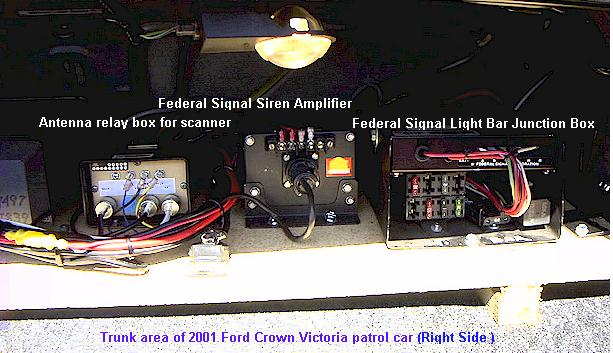
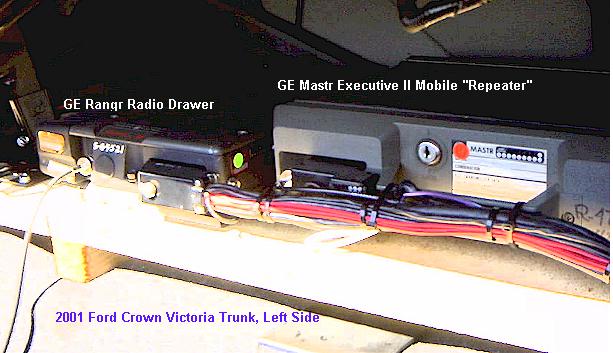
SIREN AMPLIFIER
See details of this siren amplifier on the previous page.
RADAR :
The CHP has purchased a large quantity of Stalker Ka-band radar equipment and standardized on it. A typical installation in a 2001 patrol car can be seen below, and on the motorcycle shown on my "CHP Motorcycle" page. The newest cars with the CPVE system will have this radar control unit mounted in the trunk and controlled by the "touch screen" display. See my 2009 CHP page for information on the CPVE system.
LIDAR:
By 2009 CHP had purchased 800 "Lidar" laser speed guns, a handheld device which uses a laser beam to gauge speed as opposed to the traditional Stalker radar shown above. These are used in certain areas only and are in supplement to the standard radar units, not as a replacement for them, although it is anticipated that eventually they may replace the traditional radar equipment. One perceived advantage of the Lidar equipment is that it is more accurate and harder, if not impossible, to detect.
SPECIAL EXTRA RADIOS:
Following 9/11/2001, in addition to M-16/AR-15 rifles, some divisions are equipping their cars with additional radios to allow direct coordination with local agencies on their channels, which are typically VHF high band and UHF, something which was frowned upon in years past but which is considered vital today. In some cases, the CHP has installed the trunk-mounted Kenwood TK-730 VHF high band mobile radio package, usually on top of the antenna relay box for the scanner. The Kenwood control head is then mounted on the center console box between the Bearcat scanner and the laptop computer base. See typical trunk installation below, from 2003:
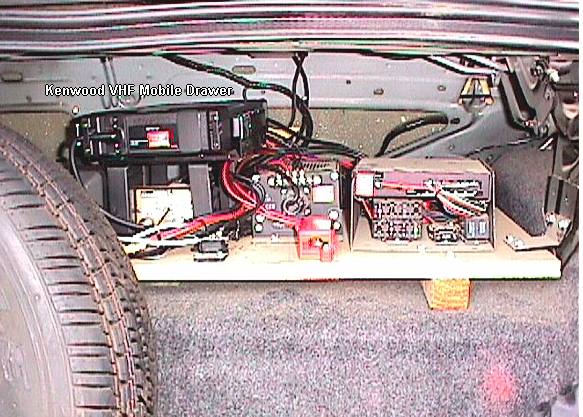
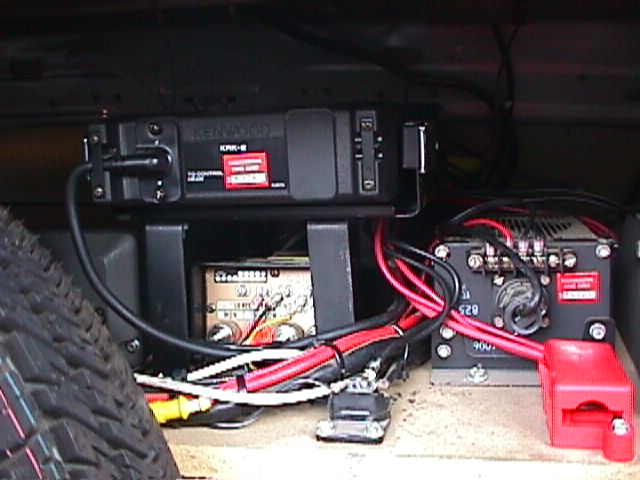
Also note that in many areas, extra radios are installed in the CHP cars by the county agencies themselves rather than CHP. The radios remain the property of the counties involved and ideally would be returned to the county when the CHP vehicle is decommissioned ("run out.") Thus there is no real standardization and almost anything might be found depending upon the area of the state.
ANTENNAS:
Up to late 2010, approximately, the standard CHP antenna configuration for the communications radios was a roof mounted loaded whip for 42 MHz and a glass mounted VHF 154 MHz antenna for the extender repeater. This low band antenna was the Antenex (now Laird) C40/MDBPST .
A few installations still used the roof mounted 1/4 wave VHF antenna for the extender rather than the glass mounted version. The ball and spring mount, so familiar in the 1960's through 1990's, was discontinued in the mid 1990's although it is still found on some special vehicles such as trucks.
There was usually also a glass mounted 800 MHz antenna for use with the mobile laptop computer cellular modem for data applications, but this setup varied throughout the state and was not present in all vehicles (such as Camaros.) It was eventually replaced in 2009 by the "hockey puck" antenna design. Commercial enforcement vehicles still carry CB radios with ball and spring mounted whips, for monitoring truckers and possibly communicating with them. See 2007 photo below (note-commercial enforcement vehicles usually do not have the standard black & white paint schemes, other than the pickup trucks.):
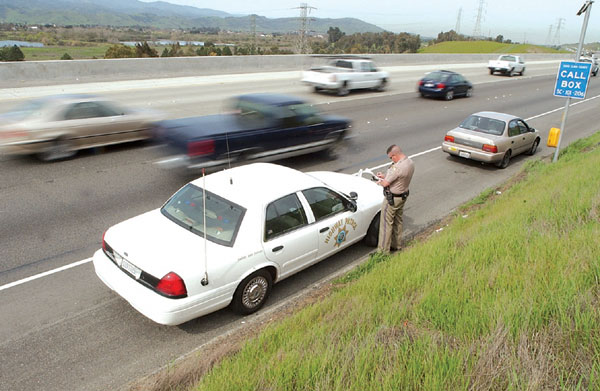
UPDATE: As of 2008, the CHP had changed most antenna installations to use all roof-mounted antennas, in other words the cellular modem, "extender" and so forth were then on the roof. The main two-way radio antenna is now an Antenex (Laird Technologies) loaded whip physically identical to its Antenna Specialists predecessor, except that it has a matching network in it for wider bandwidth operation to accommodate the new 39 and 45 MHz channels. The previous antenna was somewhat shorter and with a thinner whip rod. This antenna itself has gone through at least two versions. The current (2011) roof mount low band antenna in use is a Laird WPC39SOB-001 loaded whip, which offers better than 1.5:1 VSWR over the 39-46 MHz range.
The repeater (extender) antenna is an 18 inch whip, the scanner is a second short whip (apparently the whip length varies by division depending upon agencies it is desired to monitor,) and a "hockey puck" cellular/data subscriber and GPS antenna. All drilled through the roof. The on-glass antennas are no longer featured on these vehicles. The antenna relay box for the scanner is no longer used, a short UHF whip taking its place. See 2010 in-service photo below.
Photo below copyright and courtesy of Ten96
Here's a slightly different antenna arrangement on an '09 Dodge:
Photo below copyright and courtesy of Ten96
The antenna locations as of 2010 have been standardized into the format below, at least on the final Crown Victoria vehicles:
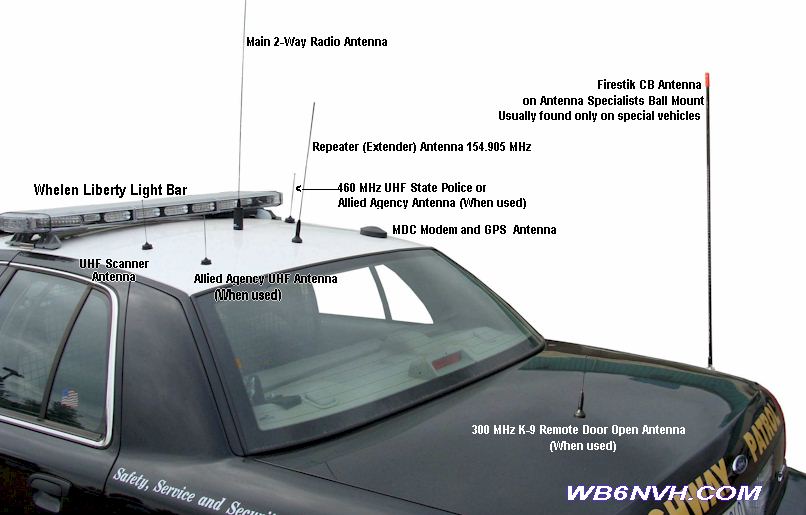
THE ANTENNAS ABOVE:
-Laird (Antenex) GPST821/18503P "Hockey Puck": Wireless MDC and GPS
-Laird (Antenex) QWB450 NMO Mount 1/4 Wave: Scanner
-Laird (Antenex) AB150S NMO Mount with spring: Repeater (extender) antenna, 154.905 MHz
-Laird (Antenex) WPC39SOB-001 wideband NMO mount in black: Low Band main two-way radio. Began to replace the Antenex (Laird) C40 / MDBPST 42 MHz antenna after late 2010.
Note also that some divisions are having radios installed by the local agencies they wish to communicate with, usually involving trunk mounted antennas. A typical example would be a VHF high band radio and antenna for coordination with a local sheriff's radio system. There is no standardization in this case. Such antennas are identified in CHP installation manuals as "Allied agency antennas" and while the CHP photo shown above directs where they are to be located, local practice seems otherwise.
A short antenna may be found mounted in the center of the trunk lid on a few cars. This is referred to as the "300 MHz K-9 Remote Door Open Antenna, 9.8 inches." This is used on the K-9 vehicles with dogs. The officer has a remote with him which when depressed, such as if he is attacked, opens the cage and allows the dog to jump from the car and assist him. One of the windows must be open and the cage opens to the front. (Thanks to Gary Saffer for this information.)
A few vehicles are equipped with Lojack systems for tracking stolen cars. These require, typically, four VHF high band quarter wave antennas in a "square" mounting configuration. Lojack equipment remains the property of the Lojack Corporation and is installed by them. Thus there is yet another non-standard antenna aspect to deal with!
MOBILE VIDEO:
Mobile video has been installed on some cars for a number of years, and as of October, 2009, the CHP will now be installing it on all patrol vehicles leaving Motor Transport in Sacramento as well as retrofitting vehicles in the field, until it is standard on every patrol car. This will include interior and exterior cameras and a wireless microphone on the officer. The initial systems are being integrated into the existing aging GE S810 control system although this is expected to rapidly transition to the new CPVE control and radio system as shown on my CHP 2009 page. Details of the system will be provided on that page as well.
AIRCRAFT:
The CHP uses aircraft in various roles. The setup used in 2008 consisted of the following:
VHF Low Band: Technisonic TFM-30
VHF High Band: Technisonic TFM-500
Aviation Frequencies: Bendix Com Radio and Garmin GNS 430 GPS/Radio
800 MHz Band: Motorola XTS3000 HT in Convertacom console, and M/A Com EDACS HT
Scanner: Uniden as in cars (later replaced by GRECOM PSR-600, and 2013+ = ?)
Satellite Phone: Globalstar (formerly Qualcomm)
In late 2008 the CHP added the Technisonic TDFM 7000 radio in place of the TFM-500. The TDFM 7000 is a multiband radio which contains VHF high band, UHF and 700/800 MHz with Motorola SmartZone and SmartNet capabilities as well as P25, which will be compatible with the new EF Johnson handhelds.
The aircraft generally communicates with the ground units on the BLUE channel, car-to-car.
Thanks to A.York of CHP for this information!
SPECIAL SERVICE MUSTANGS website has a lot of detail about the equipment used in the 1980's and 1990's Mustangs. Check that out too:
http://www.specialservicemustang.net/
FOR CHP FREQUENCY LISTS:
http://www.radioreference.com/apps/db/?aid=995
FOR MY PROGRAMMING TUTORIAL FOR THE REGULAR (NOT CHP) GE S820 and S825 CONTROL HEADS, CLICK HERE
This page is maintained by Geoff Fors, Monterey California. You can reach me at the addresses listed on my home page. I am always looking for interesting CHP photos to add to these pages. If you want to share any, let me know.
Updated 11/18/2019 © 2001, all rights reserved.